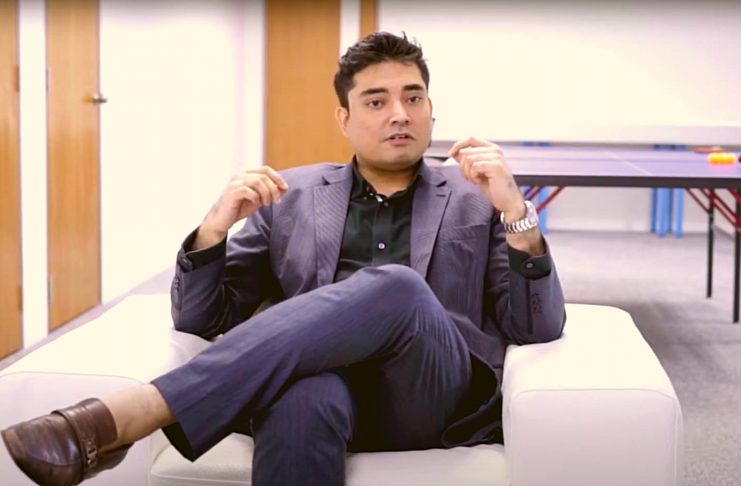Keynote Performance Mastery: Tips from Sancy Suraj
Keynote speaking is an art that requires mastery and precision. The ability to capture an audience’s attention and convey a message with impact is a skill that takes years to develop. However, some individuals seem to possess a natural flair for keynote speaking, and one such person is Sancy Suraj. As the CEO of Knowles Training Institute, The Umonics Method, and Pinnacle Minds, Sancy Suraj has trained over 10,000 people worldwide in the art of memory and is a keynote speaker and memory athlete in his own right. He holds one world Guinness record for the longest color sequence memorized and six Singapore book of records, all in memorization feats.

Can you tell us about your approach to preparing for a keynote performance? How do you ensure that you deliver a powerful and engaging presentation every time?
As a keynote speaker, I strongly believe that preparation is key to delivering a powerful and engaging presentation. My approach to preparing for a keynote performance involves several steps that help me craft a presentation that resonates with my audience and delivers the intended message effectively.
First and foremost, I begin by conducting extensive research on the topic I am going to speak about. This includes analyzing current trends and relevant data, reading industry publications, and keeping up with the latest news and developments. This helps me gain a deeper understanding of the subject matter and enables me to provide relevant and up-to-date information to my audience.
Next, I focus on creating a clear and concise message that resonates with my audience. I believe that a keynote presentation should be memorable and leave a lasting impression on the audience. Therefore, I spend considerable time and effort in crafting a message that is not only informative but also impactful and inspiring.
Once the message is finalized, I work on the delivery of the presentation. I focus on my body language, tone of voice, and pacing, to ensure that the audience is engaged throughout the presentation. I also use visual aids and storytelling techniques to keep the audience captivated and make the presentation more relatable.
Finally, I rehearse extensively before every presentation to ensure that I am well-prepared and confident. This includes practicing the delivery of the presentation, incorporating feedback from others, and mentally visualizing a successful outcome. By following these steps, I ensure that I am always well-prepared and able to deliver a powerful and engaging keynote performance every time.
What are some common mistakes that keynote speakers make, and how can they be avoided?
As a keynote speaker, I have seen several common mistakes that many speakers make during their presentations. These mistakes can hinder the effectiveness of the presentation and impact the audience’s engagement. However, they can be avoided by taking the necessary steps and practicing proper presentation skills.
One of the most common mistakes that keynote speakers make is not understanding their audience. It is crucial to know the demographics, interests, and expectations of the audience before delivering a presentation. Failing to do so can result in a message that is not tailored to the audience’s needs and may fail to resonate with them. To avoid this mistake, I suggest conducting thorough research on the audience and incorporating this information into the presentation.
Another common mistake is delivering a presentation that is not well-structured. A disorganized presentation can confuse the audience and detract from the message’s impact. To avoid this, keynote speakers should have a clear structure that follows a logical progression. This structure can include an introduction, body, and conclusion that flow seamlessly together, providing the audience with a cohesive and comprehensive understanding of the topic.
Finally, many keynote speakers fail to engage the audience effectively. This can happen when the speaker talks at the audience rather than with them, resulting in a lack of connection and engagement. To avoid this, speakers should incorporate audience participation and interaction, such as asking questions or using interactive exercises. This can help keep the audience engaged and invested in the presentation, resulting in a more memorable and impactful experience.
In summary, avoiding common mistakes such as failing to understand the audience, delivering a poorly structured presentation, and failing to engage the audience can improve the effectiveness of a keynote presentation. By taking the necessary steps, keynote speakers can craft presentations that resonate with their audience, leave a lasting impression, and inspire action.
How do you tailor your keynote performances to different audiences and venues? What factors do you take into consideration when customizing your presentation?
As a keynote speaker, I understand the importance of tailoring my presentations to different audiences and venues. Each audience has unique needs, interests, and expectations, and it is my responsibility to ensure that my presentation meets those requirements. To customize my presentations effectively, I take several factors into consideration.
Firstly, I consider the demographics and interests of the audience. For example, if I am speaking to a group of students, I may use a more interactive and engaging approach than if I were speaking to a group of executives. I also consider the industry or field that the audience belongs to, as this can affect the type of content and language that I use.
Secondly, I take into account the venue and setting of the presentation. This includes the size of the venue, the acoustics, and the lighting. For example, in a larger venue, I may use more visual aids and speak more slowly to ensure that everyone can follow the presentation. In a smaller venue, I may use more storytelling techniques and engage with the audience more directly.
Thirdly, I consider the purpose and goals of the presentation. This includes understanding what the audience hopes to gain from the presentation and the desired outcome. For example, if the presentation is meant to inspire action, I may focus more on the motivational aspects and provide clear calls to action.
Lastly, I am always open to feedback and adjusting my presentation as needed. If I receive feedback from the audience or the event organizer, I take this into account and use it to improve future presentations.
In summary, customizing a keynote presentation requires taking into account the audience, venue, purpose, and goals of the presentation. By understanding these factors, I can tailor my presentations effectively, ensuring that the audience receives a memorable and impactful experience.
“A successful keynote presentation isn’t just about delivering a message, it’s about creating an unforgettable experience that resonates with the audience and inspires action.”
Can you share some tips for overcoming nervousness or stage fright when delivering a keynote speech?
Nervousness and stage fright are common issues that many keynote speakers face, even those who have delivered several presentations. However, there are several tips that speakers can use to overcome these challenges and deliver a powerful and engaging keynote speech.
Firstly, preparation is key. By practicing the presentation thoroughly, speakers can become more comfortable with the material and reduce the chances of feeling nervous or forgetting their lines. Practicing in front of a mirror or with a small audience can also help build confidence and reduce anxiety.
Secondly, focusing on the audience can help alleviate nervousness. Rather than focusing on personal feelings of anxiety, it is important to focus on the message and the audience’s needs. By keeping the audience’s interests and expectations in mind, speakers can maintain their focus and deliver a more impactful presentation.
Thirdly, deep breathing and relaxation techniques can help reduce physical symptoms of nervousness. Before taking the stage, taking a few deep breaths or performing simple relaxation exercises can help calm the nerves and reduce anxiety.
Finally, embracing mistakes and imperfections can also help reduce nervousness. No speaker is perfect, and audiences understand that mistakes happen. By accepting this fact and not being overly critical of oneself, speakers can reduce the pressure and anxiety of the situation.
In summary, overcoming nervousness and stage fright requires preparation, focus on the audience, relaxation techniques, and embracing imperfections. By implementing these tips, speakers can become more confident and deliver more effective and impactful keynote speeches.
How do you incorporate storytelling and other engaging techniques into your keynote performances?
As a keynote speaker, I understand the importance of engaging the audience and creating a memorable experience. One of the most effective ways to do this is by incorporating storytelling and other engaging techniques into my keynote performances. Here are a few strategies that I use to achieve this goal:
Firstly, I focus on creating a compelling narrative arc that draws the audience in and keeps them engaged. This involves identifying a central message or theme and building a story around it. For example, if I am giving a keynote on leadership, I may use personal anecdotes to illustrate key principles of effective leadership.
Secondly, I use visual aids and other multimedia tools to enhance the storytelling experience. This includes using slides, videos, and other interactive elements to create a more immersive and engaging experience for the audience.
Thirdly, I strive to connect with the audience on a personal level by using humor, empathy, and relatable stories. By sharing personal experiences and using humor to lighten the mood, I create a more relaxed and engaging atmosphere that encourages the audience to connect with me and my message.
Lastly, I use interactive exercises and audience participation to keep the audience engaged and involved. This includes asking questions, soliciting feedback, and encouraging the audience to participate in group activities.
In summary, incorporating storytelling and other engaging techniques into a keynote performance requires a focus on creating a compelling narrative arc, using visual aids and multimedia tools, connecting with the audience on a personal level, and encouraging interaction and participation. By implementing these strategies, speakers can create a more memorable and impactful experience for the audience.
“Storytelling is the key to unlocking the hearts and minds of an audience, and when combined with engaging techniques and interactive exercises, it becomes a powerful tool for creating a memorable and impactful keynote experience.”
As a magazine that specializes in interviewing keynote speakers, we recently had the opportunity to sit down with Sancy Suraj and pick his brain on the secrets to his success. In this article, titled “Keynote Performance Mastery: Tips from Sancy Suraj,” we asked him ten questions that provide insights into his approach to keynote speaking. His answers are invaluable to anyone looking to develop their keynote speaking skills and leave a lasting impact on their audience.
Sancy Suraj’s approach to keynote speaking is founded on thorough preparation. He believes in customizing his presentations to different audiences and venues, incorporating storytelling and other engaging techniques to keep his audience attentive and interested. Suraj also emphasizes the importance of authenticity and vulnerability in keynote speaking, balancing personal stories with maintaining a professional image.
When developing a keynote speech, Sancy Suraj follows a meticulous process that involves extensive research, clear messaging, and effective use of visual aids. He engages with his audience throughout his presentation, utilizing strategies such as humor and audience participation to keep them engaged.
Suraj’s ability to overcome nervousness or stage fright during his keynote speeches is a testament to his years of experience in the field. He advises other speakers to practice visualization techniques and breathing exercises to calm their nerves. Additionally, he stresses the importance of being comfortable with oneself and owning one’s message to build confidence on stage.

Can you walk us through your process for developing a keynote speech from start to finish? What steps do you take to ensure that your message is clear and impactful?
Developing a keynote speech is a complex and iterative process that requires a clear understanding of the audience, the topic, and the message. Here is an overview of my process for developing a keynote speech from start to finish:
Step 1: Define the objective and audience
The first step in developing a keynote speech is to define the objective of the speech and identify the target audience. This involves understanding the needs and interests of the audience, as well as the goals and objectives of the event organizers.
Step 2: Research and brainstorm
Once the objective and audience are defined, the next step is to conduct research and brainstorm ideas for the speech. This may involve reading relevant literature, conducting interviews, and gathering data to support the key message of the speech.
Step 3: Create an outline
Based on the research and brainstorming, the next step is to create an outline for the speech. This involves organizing the ideas into a logical sequence and identifying key themes and messages to be emphasized.
Step 4: Draft the speech
Using the outline as a guide, the next step is to draft the speech. This involves writing the content and refining it to ensure that the message is clear and impactful. It is important to use engaging language and storytelling techniques to capture the audience’s attention and maintain their interest throughout the speech.
Step 5: Practice and refine
Once the speech is drafted, the next step is to practice and refine it. This involves rehearsing the speech multiple times and making adjustments to improve the delivery and impact of the message.
Step 6: Incorporate multimedia and visual aids
Finally, the speech can be enhanced by incorporating multimedia and visual aids. This includes using slides, videos, and other interactive elements to create a more engaging and immersive experience for the audience.
In summary, developing a keynote speech requires a clear understanding of the objective and audience, research and brainstorming, outlining and drafting the speech, practicing and refining the delivery, and incorporating multimedia and visual aids. By following these steps, speakers can ensure that their message is clear and impactful and that the audience is engaged and inspired.
How do you engage with your audience during a keynote performance? What strategies do you use to keep them attentive and interested?
Engaging with the audience during a keynote performance is critical to keeping them attentive and interested in the message being delivered. Here are some strategies that I use to engage with the audience and maintain their interest throughout the presentation:
Ask questions: Asking the audience questions is a great way to engage them and encourage active participation. This could involve asking for a show of hands, or even calling on individuals for their input. This not only keeps the audience engaged but also makes them feel involved and invested in the presentation.
Use humor: Incorporating humor into the keynote performance can be an effective way to keep the audience entertained and attentive. Humor can also help to lighten the mood and create a more relaxed atmosphere, which can make it easier for the audience to connect with the speaker.
Storytelling: Storytelling is a powerful tool for engaging the audience and creating an emotional connection. By sharing personal anecdotes or relatable stories, the audience can relate to the speaker and better understand the message being delivered.
Audience interaction: Creating opportunities for the audience to interact with each other and the speaker can be an effective way to maintain their attention and engagement. This could involve group activities, breakout sessions, or even a Q&A session.
Visual aids: Incorporating visual aids such as slides, videos, and graphics can also be an effective way to keep the audience engaged and interested. Visual aids can help to break up the presentation and provide a more dynamic and engaging experience for the audience.
In summary, engaging with the audience during a keynote performance requires a combination of strategies including asking questions, using humor, storytelling, audience interaction, and visual aids. By incorporating these techniques, speakers can create a more dynamic and engaging experience for the audience and ensure that their message is effectively delivered and understood.
What role do visual aids, such as slides or videos, play in your keynote performances? How do you use them effectively?
Visual aids, such as slides or videos, play a crucial role in my keynote performances. These tools can help to enhance the overall message and make it easier for the audience to understand and remember the key points. Here are some ways in which I use visual aids effectively during my keynote performances:
Enhancing the message: Visual aids can help to clarify complex ideas and make them easier to understand. By using images or diagrams, the audience can visualize and relate to the information more effectively. This can help to reinforce the overall message and make it more impactful.
Creating a visual experience: Visual aids can also create a more engaging and dynamic experience for the audience. By incorporating videos or animations, the audience can better relate to the message and remain engaged throughout the presentation.
Breaking up the presentation: A lengthy keynote performance can be overwhelming for the audience. Visual aids can help to break up the presentation and make it more manageable. By including interactive elements, such as quizzes or polls, the audience can stay engaged and interested.
Supporting storytelling: Visual aids can also support storytelling by providing context or additional information. By using images or videos that relate to the story being told, the audience can better connect with the speaker and the message.
To use visual aids effectively, I ensure that they are relevant to the overall message and used sparingly. I also avoid using too much text or cluttering the slide with unnecessary information. By keeping the visual aids simple and relevant, I can enhance the overall message and make it more impactful. Additionally, I practice using the visual aids beforehand to ensure that the presentation is seamless and flows smoothly. Overall, visual aids can be a powerful tool for enhancing the message and engaging the audience during a keynote performance.
Can you discuss the importance of authenticity and vulnerability in keynote speaking? How do you balance sharing personal stories with maintaining a professional image?
Authenticity and vulnerability are crucial in keynote speaking because they allow the audience to connect with the speaker on a deeper level. When a speaker shares personal stories or experiences, it humanizes them and makes them relatable to the audience. This can create a sense of trust and connection between the speaker and the audience, making the overall message more impactful.
However, it is important to balance authenticity and vulnerability with maintaining a professional image. Keynote speakers are often seen as thought leaders and experts in their respective fields, and it is important to maintain that level of credibility. This means being selective about the personal stories that are shared and ensuring that they are relevant to the overall message.
In my experience, I have found that authenticity and vulnerability are most effective when they are used to support a larger message or theme. By sharing personal stories that are relevant to the overall message, the audience can better connect with the speaker and the message. Additionally, I always ensure that the personal stories I share are appropriate for the audience and the venue.
One way to balance authenticity and vulnerability with professionalism is by being strategic about the delivery of personal stories. Instead of sharing them all at once, I weave them throughout the presentation to create a natural flow. This allows the audience to see the speaker’s personal side without detracting from the overall message.
Ultimately, the key to balancing authenticity and vulnerability with professionalism is by being intentional and selective with what is shared. By sharing personal stories that are relevant and appropriate, the audience can better connect with the speaker and the overall message can be more impactful.
What advice would you give to someone who is just starting out in the field of keynote speaking? What are some key principles or strategies that they should keep in mind?
If someone is just starting out in the field of keynote speaking, my advice would be to focus on developing their message and honing their delivery skills. Here are some key principles and strategies to keep in mind:
Find your unique perspective: The most successful keynote speakers have a clear and unique perspective on their topic. It’s important to identify what makes your perspective different and focus on that.
Practice, practice, practice: Delivering a powerful and engaging keynote speech takes practice. It’s important to rehearse your speech multiple times and get feedback from others. This will help you refine your message and delivery.
Know your audience: Understanding your audience is crucial to delivering an effective keynote speech. It’s important to research the audience beforehand and tailor your message to their needs and interests.
Use stories and examples: Stories and examples are a powerful way to connect with your audience and make your message more memorable. Incorporating relevant and engaging stories into your speech can make a big difference.
Use visuals strategically: Visual aids can be a great way to enhance your message, but it’s important to use them strategically. Avoid using too many slides or distracting graphics that may detract from your message.
Embrace feedback: Receiving feedback, both positive and negative, can help you improve your message and delivery. It’s important to be open to feedback and use it to refine your skills.
Develop your personal brand: Building a personal brand as a keynote speaker can help you stand out in a crowded field. This includes developing a strong online presence and networking with other industry professionals.
Overall, the key to success in keynote speaking is to focus on delivering a clear and engaging message that resonates with your audience. By following these principles and strategies, new keynote speakers can build a strong foundation for success in the field.
“Effective keynote speaking is not just about delivering a message, but about creating a connection with your audience through the power of your words and delivery.”
In conclusion, Sancy Suraj’s insights into keynote speaking provide invaluable advice for those looking to improve their skills. From preparation to engaging with audiences and utilizing visual aids, his approach is founded on the principles of thoroughness and authenticity. His tips on overcoming nervousness and stage fright also serve as excellent advice for those just starting out in the field. Overall, Sancy Suraj’s expertise in the field of keynote speaking is a testament to his success as a speaker and trainer.





